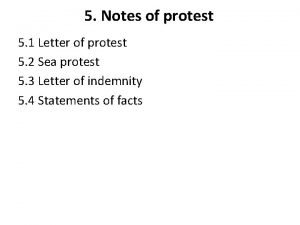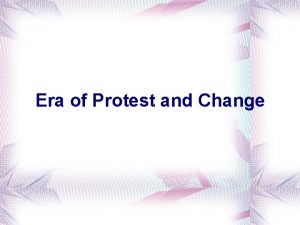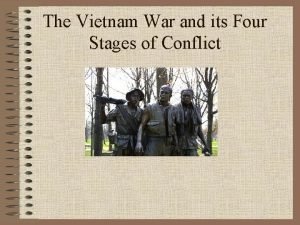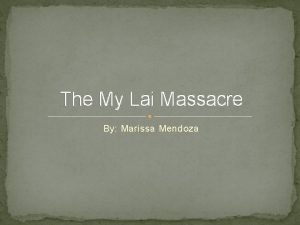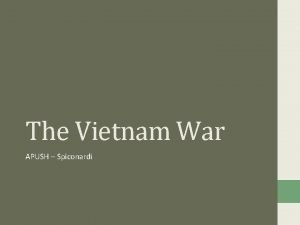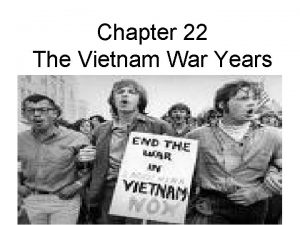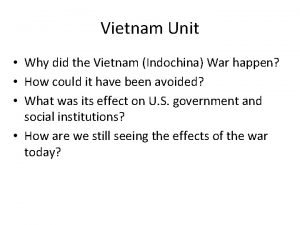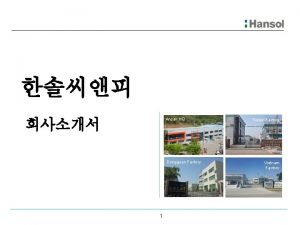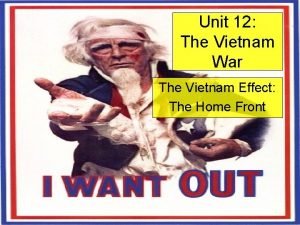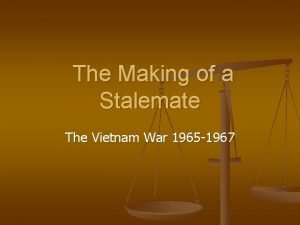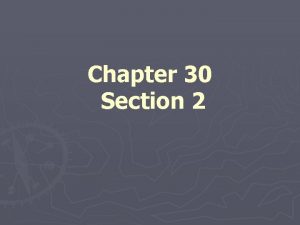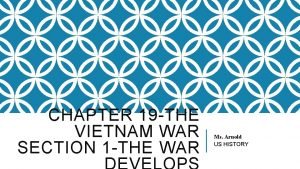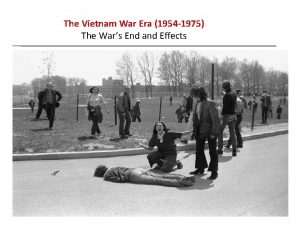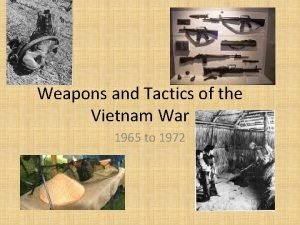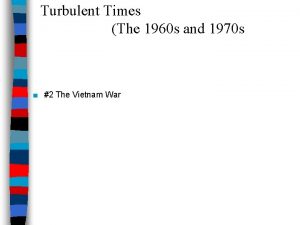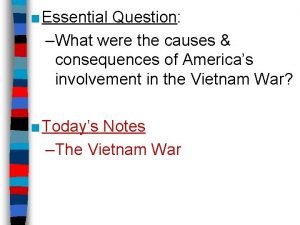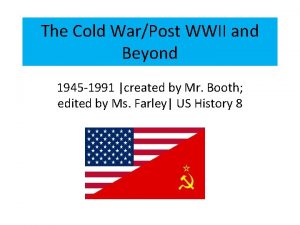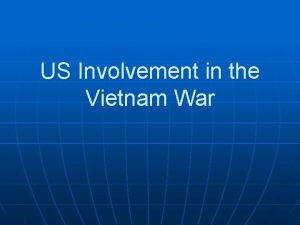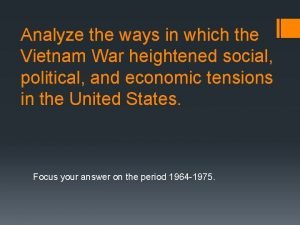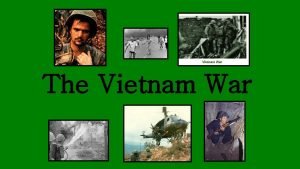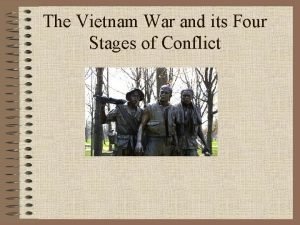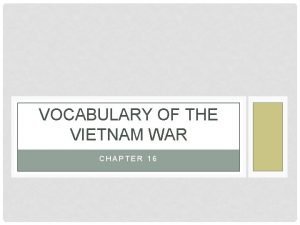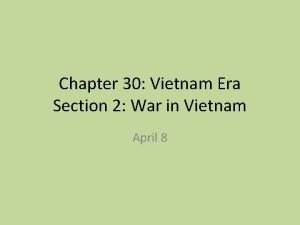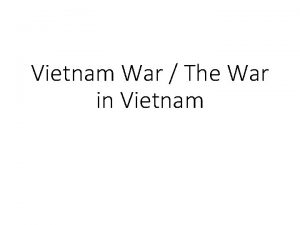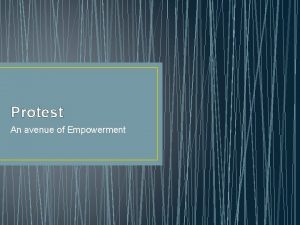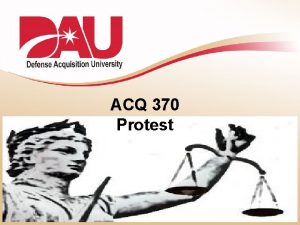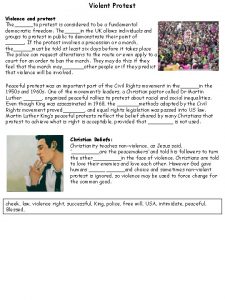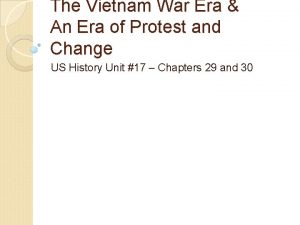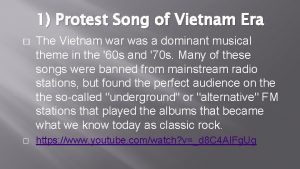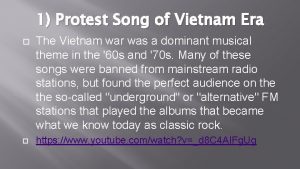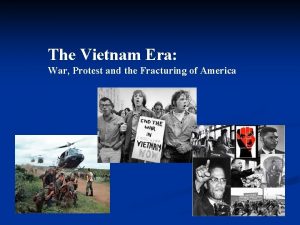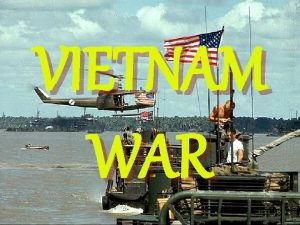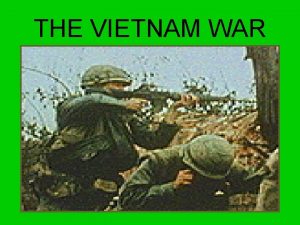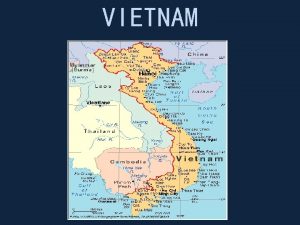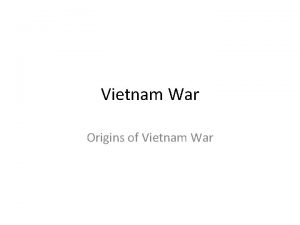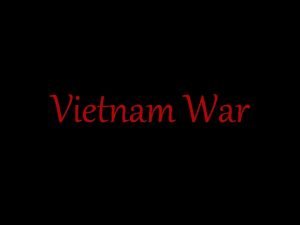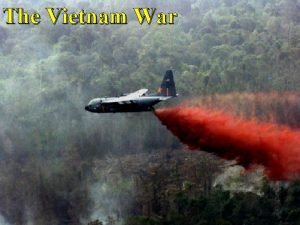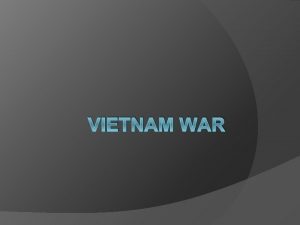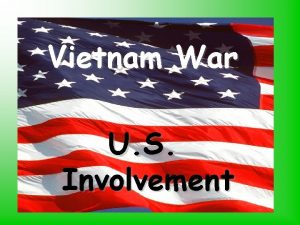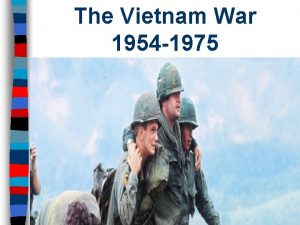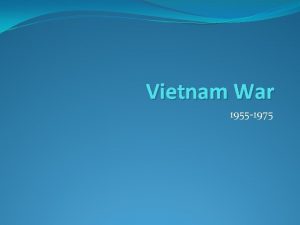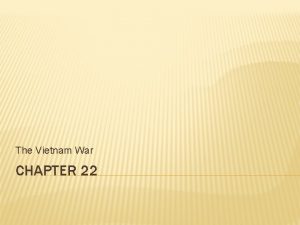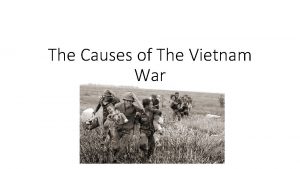The Vietnam War Era An Era of Protest

























- Slides: 25

The Vietnam War Era & An Era of Protest and Change U. S History

Ho Chi Minh The most important leader for Vietnamese independence; Born in 1890, Ho became involved in anti-French organizations as a young man. In 1912 he left Vietnam and traveled the world before ending up in Moscow, where he was trained in communist ideas. He returned to Vietnam after WWII, leading rebels to defeat the French in 1954, then continuing the fight against the United States.

Dien Bien Phu French military base in northwest Vietnam in which Ho Chi Minh’s army, known as the Vietminh, trapped a large French garrison in 1954. After suffering 15, 000 casualties, the French surrendered. At a peace conference in Geneva in 1955 the Vietnamese agreed that their country would be divided in two: North Vietnam was to be ruled by Ho Chi Minh’s communists; South Vietnam, by an anticommunist government supported by the United States.

Closure Question #1: Identify one argument for and one argument against Truman’s decision to support the French rather than the Vietnamese nationalists. (At least 2 sentences) Vietnam thus became a pawn in Cold War politics. To ensure French support in the Cold War, Truman agreed to aid France’s efforts to regain control over Vietnam. After communist forces won the civil war in China in 1949, American increased its aid to the French in Vietnam. Truman did not want to see another communist victory in Asia. Between 1950 and 1954, the United States contributed $2. 6 billion to France’s war efforts. Containing Ho Chi Minh’s communist Vietminh – an abbreviation for the Independence of Vietnam – became a national priority. When President Dwight D. Eisenhower took office in early 1953, he continued Truman’s policies toward Vietnam. He sent monetary aid to the French, arguing that by battling Ho Chi Minh, they were containing the spread of communism. The domino theory was the idea that if Vietnam fell to communism, its closest neighbors would follow. This in turn would threaten Japan, the Philippines, and Australia. In short, stopping the communists in Vietnam was important to the protection of the entire region.

SEATO / Vietcong SEATO – Southeast Asia Treaty Organization; Alliance of seven Asian countries and the United States whose goal was to contain the spread of communism in Southeast Asia; Through SEATO the U. S. provided economic and military aid to South Vietnam. Vietcong – Communist guerrilla fighters within South Vietnam that wanted to unite Vietnam under a communist government. The Vietcong used surprise hit-and-run tactics to assassinate government officials and destroy roads and bridges, weakening support of the anti-communist government led by Ngo Dinh Diem.

Closure Question #2: What goals motivated President Kennedy’s policy decisions regarding Vietnam? (At least 1 sentence) After his election in 1960, President John F. Kennedy took a more aggressive stand against the communists in Vietnam. Beginning in 1961, he sent Special Forces troops to South Vietnam to advise the Army of the Republic of Vietnam (ARVN) on more effective ways to fight the communist forces. By 1963, more than 15, 000 American “advisers” were fighting in Vietnam. Although U. S. advisers fought bravely and achieved some success, Diem continued to alienate South Vietnamese citizens. By late 1963, his regime was in shambles. Buddhists protested his restrictive policies, occasionally by setting themselves on fire. The Kennedy administration eventually concluded that South Vietnam needed new leadership. Working behind the scenes, Americans plotted with anti-Diem generals to overthrow Diem’s government. On November 1, 1963, Diem was removed from power and later assassinated.

Closure Question #3: How did the Maddox incident contribute to the outbreak of war? How did it lead to a change in the balance of power in the American government? (At least 2 sentences) Gulf of Tonkin Resolution On August 2, 1964 a North Vietnamese torpedo boat fired on the American destroyer USS Maddox in the Gulf of Tonkin off the coast of North Vietnam. Congress passed the resolution, authorizing the use of American military force in Vietnam, giving President Johnson the power to commit U. S. troops to the area to “defend American troops”, though an official war had not been declared.

Closure Assignment #1 Answer the following questions based on what you have learned from Chapter 29, Section 1: 1. Identify one argument for and one argument against Truman’s decision to support the French rather than the Vietnamese nationalists. (At least 2 sentences) 2. What goals motivated President Kennedy’s policy decisions regarding Vietnam? (At least 1 sentence) 3. How did the Maddox incident contribute to the outbreak of war? How did it lead to a change in the balance of power in the American government? (At least 2 sentences)

William Westmoreland / Napalm & Agent Orange William Westmoreland – The American commander in South Vietnam; Along with Secretary of Defense Robert Mc. Namara, Westmoreland believed the U. S. needed to increase its military presence in Vietnam and do more of the fighting in order to defeat the Vietcong. Following Westmoreland’s advice, in 1965 President Johnson increased U. S. troop numbers to 180, 000 and authorized extensive bombing of North Vietnam. (a. k. a. Operation Rolling Thunder) Napalm – Jellied gasoline which was dropped in large canisters that exploded on impact, covering large areas with flames. Agent Orange – An herbicide designed to kill plant life; In Vietnam U. S. forces used Agent Orange to deforest the countryside and destroy enemy crops. Many scientists believe that Agent Orange causes cancer.

Closure Question #1: What military strategies did the United States employ in Vietnam? How successful were these strategies? (At least 2 sentences) As airstrikes intensified, American ground troops landed in South Vietnam. On March 8, 1965, U. S. Marines arrived to defend the airbase at Da Nang. They were soon followed by other troops. The soldiers accepted a wide range of missions. Some guarded bases. Others conducted search-and-destroy missions to kill as many Vietcong guerrillas as they could. Helicopters ferried commandos to and from remote locations for quick strikes against enemy positions. Large-scale battles against Vietcong or North Vietnamese Army units were not typical of America’s strategy in Vietnam. American soldiers generally fought lightly armed Vietcong guerrillas in small engagements. The Vietcong traveled light, often carrying just a rifle and a few handfuls of rice. They dug tunnels to hide in during the day and emerged at night to ambush American patrols. They infiltrated American bases and set off explosives. They set booby traps that maimed and crippled American troops. Their strategy was to wear the Americans down. The leaders of North Vietnam and the Vietcong remained convinced that if they could avoid losing the war, the Americans would eventually leave. American strategy during this stage of the war yielded limited results. U. S. bombers did disrupt North Vietnamese industry and slow the movement of supplies to the Vietcong. But when the communists did not sue for peace. American troop commitments and battlefield deaths escalated rapidly. By the end of 1965, there were 184, 300 U. S. troops in Vietnam and only 636 American soldiers had died in the war. Three years later, there were more than a half million U. S. troops in Vietnam and the number of American dead had risen to more than 30, 000.

John Mc. Cain Born in 1936 into a military family, Mc. Cain graduated from the Naval Academy and became a jet pilot. While serving in Vietnam in 1967, his plane was shot down and he was held prisoner in North Vietnam for over 5 years. Following his release in 1973, Mc. Cain spent 8 more years in the Navy before becoming a politician.

Closure Question #2: What difficulties did American soldiers face in Vietnam? What effect did these difficulties have? (At least 2 sentences) American forces supported the survival and development of South Vietnam, which was besieged by the Vietcong and their North Vietnamese allies. In this fight, U. S. troops could never fully tell their friends from their enemies. Yet from the outset, they faced the dangers of Vietnam’s battlefields with dedication and bravery. Although American troops won numerous battles, they could not win the war outright. The problem was that the Vietcong and North Vietnamese avoided significant engagements. Rather than expose themselves to superior American firepower, the communists fought smaller skirmishes where their small-unit abilities and their knowledge of the landscape bettered their chances for victory. U. S. forces often had no alternative but to fight indecisive battles in the jungles, rice paddies, and mountains of Vietnam. Most of these battlefields abounded with natural cover. Clad in black pajamas, Vietcong gunmen would spring out of the dense foliage, attack with automatic rifles and grenades, and disappear back into the landscape. Much of the fighting took place at night, which reduced the effectiveness of American planes, artillery, and troops tactics.

Closure Question #3: How did the disagreements between hawks and doves reflect different views about war and world politics? (At least 2 sentences) Hawks / Doves Hawks – Conservative congressmen who supported President Johnson’s war policy in Vietnam due to their strong belief that communism needed to be contained. Doves – Liberal congressmen who opposed President Johnson’s war policy in Vietnam, questioning the war on both moral and strategic grounds. The doves argued that the conflict in Vietnam was a local civil war, not a vital Civil War battleground.

Closure Assignment #2 Answer the following questions based on what you have learned from Chapter 29, Section 2: 1. What military strategies did the United States employ in Vietnam? How successful were these strategies? (At least 2 sentences) 2. What difficulties did American soldiers face in Vietnam? What effect did these difficulties have? (At least 2 sentences) 3. How did the disagreements between hawks and doves reflect different views about war and world politics? (At least 2 sentences)

Closure Question #1: Identify three factors that led to the growth of the antiwar movement. Which do you think was the most important? (At least 1 sentence) Draftees / Deferments Draftees – Young men drafted into military service; By 1965, most of the troops sent to Vietnam were no longer volunteers, but instead were draftees. In total, the U. S. government drafted 1. 5 million men into military service during the Vietnam War. Deferments – A postponement of military service; According to the Selective Service Act of 1948, men who were in college or who worked in certain occupations could have their military service deferred. Critics argued that as a result of these policies minorities and the poor were bearing most of the military burden while the wealthy and white young men avoided military combat.

Closure Question #1: Identify three factors that led to the growth of the antiwar movement. Which do you think was the most important? (At least 1 sentence) Students for a Democratic Society (SDS) Founded in 1960 at the University of Michigan to campaign against racism and poverty. The SDS changed its focus in the mid-1960 s to campaign to end the war in Vietnam, organizing demonstrations against the war and encouraging draft-age males to sign “We Won’t Go” petitions.

Closure Question #1: Identify three factors that led to the growth of the antiwar movement. Which do you think was the most important? (At least 1 sentence) “Credibility Gap” The American public’s growing distrust of statements made by the government; During the Vietnam War, President Johnson’s administration repeatedly issued optimistic statements regarding the conflict while journalists reporting from the battlefield painted a gruesome picture of death and destruction with no victory in sight.

Closure Question #2: How did the military outcome of the Tet Offensive differ from its impact on the American people? (At least 2 sentences) In November 1967, President Johnson brought General Westmoreland home from Vietnam to address the nation’s concerns about the war. Westmoreland said that the Vietcong were declining in strength and could no longer mount a major offensive. As Westmoreland made his claims, however, the North Vietnamese and Vietcong were planning just such an attack. In early 1968, U. S. officials anticipated a communist offensive. As expected, on January 21, the North Vietnamese Army hit Khe Sanh in northwest South Vietnam. The Tet Offensive – named after the Vietnamese lunar new year – was a coordinated assault on 36 provincial capitals and 5 major cities, as well as the U. S. embassy in Saigon. The communists planned to take and hold the cities until the urban population took up arms in their support. They thought the Tet Offensive had a good chance of ending the war. The fighting was fierce, but in the end the American and South Vietnamese forces repelled the offensive and there was no popular uprising against the government of South Vietnam. Although U. S. forces won a tactical victory by preventing the Vietcong and North Vietnamese Army from achieving their primary objectives, the Tet Offensive was a strategic blow to the Americans. It demonstrated that the communists had not lost the will or the ability to fight on.

Closure Assignment #3 Answer the following questions based on what you have learned from Chapter 29, Section 3: 1. Identify three factors that led to the growth of the antiwar movement. Which do you think was the most important? (At least 1 sentence) 2. How did the military outcome of the Tet Offensive differ from its impact on the American people? (At least 2 sentences) 3. What were the chief weaknesses of the Democrats in the 1968 election? How did these weaknesses aid the election of Richard Nixon? (At least 2 sentences)

Closure Question #1: How did Nixon redirect the peace process when he became President? Did his plan have the desired result? (At least 2 sentences) Vietnamization Policy for withdrawal from Vietnam presented by President Nixon; U. S. forces would withdraw as the Army of the Republic of Vietnam (ARVN) assumed more combat duties. Though the hope of the policy was that the ARVN would be able to secure South Vietnam with aid from the U. S. behind the front lines, the reality was that the ARVN troops were outnumbered and outgunned without U. S. combat troops.

Closure Question #2: What impact did the events of 1970 and 1971 have on Nixon’s actions in Vietnam? (At least 1 sentence) Kent State University (May 1970) Following the U. S. bombing of communist supply lines in Cambodia, antiwar demonstrators protested at Kent State, throwing rocks and bottles at members of the National Guard. When one guardsman thought he heard a sniper’s shot, he fired his rifle, prompting other guardsmen to fire as well into a group of protesters, killing four youths. The killings led to increased protests nationwide.

Closure Question #2: What impact did the events of 1970 and 1971 have on Nixon’s actions in Vietnam? (At least 1 sentence) My Lai / Pentagon Papers My Lai – (March 16 th, 1968) American troops led by Lieutenant William Calley shot and killed between four and five hundred unarmed civilians. Lt. Calley later said that he was following orders, but many soldiers present did not participate in the massacre. Life magazine published photos taken during the event in 1971, forcing the military to try Lt. Calley for his participation in the attack. The massacre, its coverup, and Calley’s trial fueled anti-war protest in the United States while tarnishing America’s international reputation. Pentagon Papers – Classified government history of American involvement in Vietnam which was leaked to the NY Times in 1971. The Papers revealed that American leaders involved the U. S. in Vietnam without fully informing the American people and occasionally lied to Congress.

Closure Question #2: What impact did the events of 1970 and 1971 have on Nixon’s actions in Vietnam? (At least 1 sentence) Paris Peace Accords (January 1973) Agreement signed by the United States, South Vietnam, North Vietnam, and the Vietcong which ended U. S. involvement in Vietnam. The parties agreed to a cease fire, U. S. troop withdrawal from South Vietnam, and that POWs would be exchanged. However, North Vietnamese troops would remain in South Vietnam, and in the spring of 1975 the South Vietnamese capital of Saigon fell to the communists, who unified Vietnam under one government.

Henry Kissinger A German-born Jewish man, Kissinger and his family immigrated to the U. S. in 1938 at the age of 15 to escape Hitler’s persecution of Jews. Kissinger earned a Ph. D. at Harvard in 4 years and became Richard Nixon’s leading adviser on national security and international affairs, becoming Secretary of State in 1973.

Realpolitik (German for “real politics”) Nixon and Kissinger’s shared belief that political goals should be defined by concrete nationalist interests instead of abstract ideologies. Both argued that America needed to move past the Cold War stereotype of communism vs. democracy as evil vs. good, but instead recognize that communist nations could prove loyal allies while democratic nations could become enemies.
 A letter of protest
A letter of protest Vietnam war
Vietnam war Sclc and sncc venn diagram
Sclc and sncc venn diagram An era of protest and change
An era of protest and change Stages of the vietnam war
Stages of the vietnam war Vietnam war massacre
Vietnam war massacre Vietnam war apush
Vietnam war apush The vietnam war years chapter 22
The vietnam war years chapter 22 Reason for vietnam war
Reason for vietnam war Napalm vietnam war
Napalm vietnam war Vietnam war
Vietnam war Pro vietnam war slogans
Pro vietnam war slogans Did the vietnam war end in a stalemate
Did the vietnam war end in a stalemate Chapter 30 section 5 outline map the vietnam war
Chapter 30 section 5 outline map the vietnam war President nixon endorsed vietnamization because
President nixon endorsed vietnamization because Effects of the vietnam war
Effects of the vietnam war Us weapons vietnam war
Us weapons vietnam war Vietnam war 1960
Vietnam war 1960 What were the causes and effects of the vietnam war
What were the causes and effects of the vietnam war Vietnam war at home webquest answers
Vietnam war at home webquest answers Vietnam
Vietnam Analyze the ways in which the vietnam war heightened social
Analyze the ways in which the vietnam war heightened social Vietnam war summary
Vietnam war summary Stages of the vietnam war
Stages of the vietnam war Vietnam war vocabulary
Vietnam war vocabulary Era section 2
Era section 2
